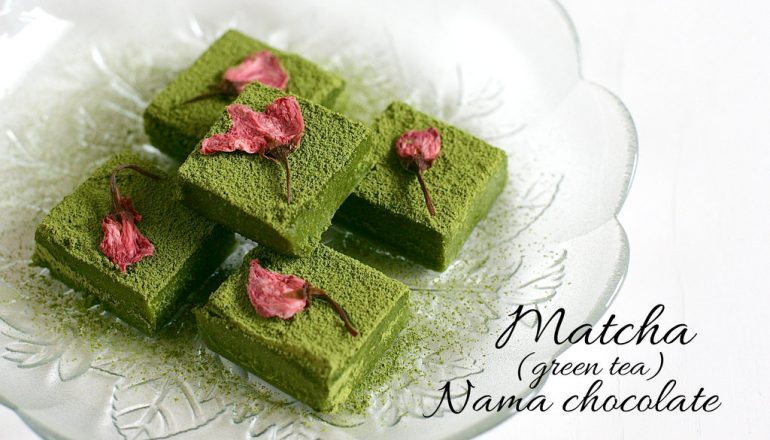Have you ever heard of nama chocolate? It is basically a very thick, rich and velvety chocolate candy that contains mostly cream and chocolate. Its texture is quite distinct from the regular chocolate mostly from the extremely high moisture content from the large amount of cream used. Its velvety and silky palate often reminds us of freshness. That’s why sometimes you will hear people call it “fresh” chocolate. Nama chocolate is originated from Japan and the most well-known brand is Royce. Before, only when I visited Japan or had a flight layover could I buy these unique delicacies. They have many different flavours, and the flavour that I particularly like is matcha (green tea). Well, I’m not the kind of person who travels often (not that I want to, I’d rather stay in the kitchen  ); hence I need to re-create this candy at home to satisfy my craving. And guess what, they are surprisingly easy to make and taste just as delicious.
); hence I need to re-create this candy at home to satisfy my craving. And guess what, they are surprisingly easy to make and taste just as delicious.
In this post, I would introduce a recipe to make Sakura Matcha Nama Chocolate. Sakura is the Japanese name for cherry blossoms, the famous spring flower that is the essence of this nation. My version of nama chocolate is pretty much similar to other recipes you can find on the internet. However, I did add a small amount of sakura leaf powder because I personally really like the combination of sakura and matcha. It’s a pretty interesting combo, very subtle and elegant, reminding me of the image of a young Japanese lady under the beautiful sakura tree. Beautiful! It may not be easy to find sakura leaf powder outside of Japan; but this ingredient is totally optional. Matcha powder alone already gives a powerful taste to the nama chocolate.
If you are really curious, you may be able to find salted sakura petals and sakura leaf powder from this website: http://anything-from-japan.com/ . It is a pretty good website with guaranteed quality of goods and fast shipping time. It can be expensive though.
Anyhow, let’s get going!
SAKURA MATCHA NAMA CHOCOLATE
Tools: A square container or pan of 10 x 10 cm dimension, or a rectangular container/pan of similar dimension; parchment paper
INGREDIENTS
- 16 salted cherry blossom (sakura) flowers (optional)
- 12 gram matcha powder
- 1 – 2 gram sakura leaf powder (optional)
- 70 ml (67 – 68 gram) whipping cream 30 – 40% fat
- 20 gram unsalted butter
- 200 gram white chocolate
INSTRUCTION
As for the method, you will notice that I’m doing it a little bit different than what is instructed in other recipes. A lot of nama chocolate recipes ask for whipping cream to be heated up; the hot cream is then poured onto the chocolate. I myself prefer to use the double-boil method so that the chocolate can slowly melt and blend in with the cream. Why? Because heating whipping cream is quite a “dangerous” process. If you overheat it, the lipid globules will crystallize, destroying the characteristics and taste of the cream. In addition, pouring cream that is too hot will cause the chocolate to be seized, resulting in a grainy/lumpy mixture. Hence, I choose the safe method that allows gentle steam from the simmering water to heat up the bowl, and in turn melt the chocolate.
A detailed recipe with all the specific notes is available on Savoury Days’ YouTube Channel (subscribe to get all the newly uploaded recipes) in both English and Vietnamese (select your preferred language by clicking CC > Setting > Language). You guys can check it out at this link or the video right below.
Printable Recipe
1. Soak the salted sakura petals in water for about an hour to remove excess salt. Then, squeeze to drain the liquid out and leave on a piece of paper until they are completely dry.
2. Cut out a piece of parchment paper that is enough to cover the bottom and sides of the container/pan. Lightly brush the inside of the pan with melted butter or sprayed cooking oil before lining it with parchment paper. This is to help keeping the parchment paper in place.
3. Combine matcha powder and sakura leaf powder (if applicable).
4. In a clean, dry bowl, add in whipping cream, butter and chocolate that have been cut into small pieces. Add a small amount of water into a small saucepan and allow it to bring to a boil, then reduce the heat until the water just simmers. Place the bowl on top of the saucepan (Note: bottom of the bowl does not touch the water). Stir continuously. The steam from the simmering water will melt the chocolate and the constant stirring will help blending everything until it becomes a smooth, homogenous mixture. Remove the bowl from heat.
5. Sift in ½ of the matcha powder/sakura leaf powder mixture into the bowl, and blend until everything is fully incorporated. Give it a taste. Continue to sift in more matcha powder/sakura leaf powder until the flavour suits your taste. Note that the more matcha powder is added, the more bitter it may become. We will also sift in some more powder in the final process.
6. Pour this mixture into the prepared container/pan. If you see there are many tiny air bubbles on the surface, slam the pan on the table a few times and they will pop (this is not very important and will not affect the quality of the chocolate).
Place the pan into the fridge for 4 – 5 hours or longer until the chocolate firms up completely.
7. Remove nama chocolate from the container/pan and cut it into bite-sized pieces using a sharp knife. You can dip the knife into boiling water and wipe it dry before cutting; this makes the cutting easier. Clean the knife after each cut.
8. Dust a thin layer of matcha powder and sakura leaf powder on top of the nama chocolate. You can place the pieces back into the container before dusting. Store in the fridge. Just before serving, dust some more powder and decorate with salted sakura petals.
Always store the nama chocolate in the fridge, use as soon as possible when it’s still fresh.
Enjoy!
- Recipe by: Linh Trang
- Written by: San Luong




JOIN US